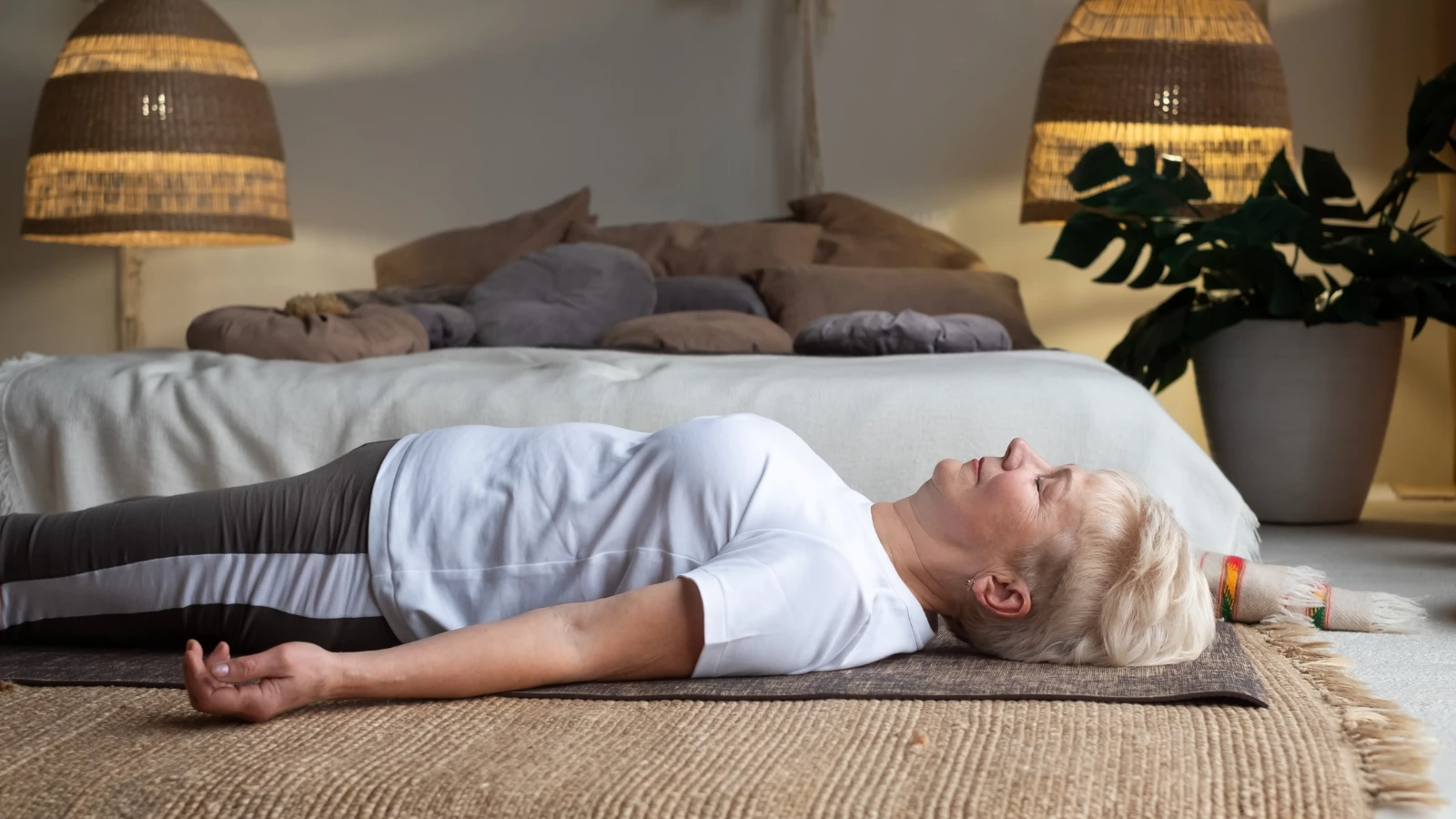Yoga Bliss: The Neuroscience Behind It

Article At A Glance
Eyes closed, I’m lying on my back in Savasana at the end of an arduous hour and a half Vinyasa class. My body feels heavy and melting into the floor, my breathing slowed to 3 to 4 times per minute. My mind floats above the clouds.
I’m lost in the moment. Time stands still. I never want to leave.
Ahhh. Yoga bliss. It’s the runner’s high; euphoria; being in the zone; floating away on cloud 9.
What Creates Yoga Bliss?

To many yogis, yoga bliss comes from spiritual awakening, as described in yoga teachings.
As one who sees the world through a scientific lens, what interested me was what is going on inside the brain as we navigate asanas.
The answer? Extensive sensorimotor input. Specifically, vestibular input (sense of balance from moving in a different plane); proprioceptive input (sense of body awareness from input into the joints and muscles); and deep pressure touch applied to your body against floor or wall.
Power of Our Near Senses
Informing us of what is happening inside our bodies, these three “near” senses are primary and our power senses. Our “far” senses—seeing, hearing, smelling, tasting, and touching—inform us of what is happening outside our bodies and are secondary.
Consider this. We could live without sight, hearing, smell, and taste and some do. But life without feeling your skin burning, or knowing you are about to fall, or where your body is in the dark would threaten survival. In fact, the far senses evolved from and are dependent upon the near senses to make sense of our world.
Vestibular Input

Vestibular input happens with each head change as we move through space in different directions: upright, forward, backward, rotated; up to down; down to up; side to side. These head changes alert the brain to a change of position to maintain balance and perspective.
Upside-down poses especially enact a huge vestibular surge. If you still feel settled hours after a morning class with challenging poses like headstands, handstands, and Bakasana (Crow), thank vestibular hits for this.
Proprioception
Proprioception comes from balancing and weight-bearing postures, from changing body positions, and from postures involving push/ pull (flexion/extension) into joints and muscles (“heavy work”). Pressure into the joint sends information to the brain about where your body is in space to enhance body awareness.
You get heavy work from strenuous activities like standing on one leg, pushups, jumping rope, biking uphill, and weightlifting. You also get it from chomping, chewing, and sucking. This helps to explain why we eat when we’re upset or nervous.
Deep Pressure Touch
 Deep pressure touch, the most calming form of input—think bear hug!—comes from your body and bare feet pushing into floor or mat and hands pressed into various parts of the body for support.
Deep pressure touch, the most calming form of input—think bear hug!—comes from your body and bare feet pushing into floor or mat and hands pressed into various parts of the body for support.
Biochemistry Released During Yoga Asanas
As you move from Urdhva Mukha Svanasana (Upward-Facing Dog) (above) to Adho Mukha Svanasana (Downward-Facing Dog) (below), from Virabhadrasana I (Warrior I) to Virabhadrasana II (Warrior II), from Bakasana (Crow) to handstand, you get a wallop of these three primary senses.
All that sensorimotor input releases at once a calming, and energizing chemical cocktail: Dopamine, our reward neurotransmitter; Oxytocin, our “love” hormone; Serotonin, our feel-good neurotransmitter; Endorphins, the brain’s opium—and all in the right balance that no pill can match. In fact, many research studies have found a consistent yoga practice to reduce depression better than anti-depressants and with a longer-lasting effect.
At the same time, you get a huge dose of energy and mild stimulation from invigorating adrenaline and norepinephrine-type stimulating compounds. This release happens especially after a strong vestibular hit from difficult inversions, like a headstand, where energy pulses through your limbs, and you feel so alive.
Bliss Varies with Type of Yoga Practice
Yoga classes vary in their blissed-out impact. Depending on the extent and intensity of these primary power senses during practice, bliss will fluctuate from “I feel settled, tranquil, and content” to “I feel alive, exhilarated, and euphoric!”
In classes that require stamina, flexibility, and mastery of your body, like Power Vinyasa and Ashtanga, strong proprioceptive and vestibular sensation interweave throughout the practice. This happens especially from challenging inversions and balancing postures.
 As a senior with a slew of physical problems, including lordosis of spine and neck, scoliosis, and fused vertebrae, I taper my practice: I step, not leap from Adho Mukha Svanasana (Downward-Facing Dog) to Uttanasana (Forward Bend); I slide from Phalakasana (Plank) to Urdhva Mukha Svanasana (Upward-Facing-Dog), skipping Chaturanga between the two poses; I squat, place my hands on the floor and lean forward in Bakasana (Crow), omitting the lifting of feet to balance on arms.
As a senior with a slew of physical problems, including lordosis of spine and neck, scoliosis, and fused vertebrae, I taper my practice: I step, not leap from Adho Mukha Svanasana (Downward-Facing Dog) to Uttanasana (Forward Bend); I slide from Phalakasana (Plank) to Urdhva Mukha Svanasana (Upward-Facing-Dog), skipping Chaturanga between the two poses; I squat, place my hands on the floor and lean forward in Bakasana (Crow), omitting the lifting of feet to balance on arms.
And so I might not experience the deep euphoria that I did when younger. Still, I feel more content at the end of a yoga class than I do with any other activity in my life. Studies back up my experience. Research supports greater emotional stability and well-being from yoga practice than other types of exercise like aerobics. “I Do Yoga to Burn Off the Crazy,” touts a yoga T-shirt so popular it’s sold in the mega-giant Walmart.
Off the Mat
The enthusiastic serenity you feel following a yoga class will last in the nervous system from a few hours to six hours if you’ve gotten a vestibular pow. To feel balanced throughout the day, you need to incorporate strong sensorimotor input off the mat as well.
For vestibular input, relax at home with things that move like rockers, gliders, hammocks, and, my favorite, a hanging hammock swing. Roll back and forth on a therapy ball. Spin like a whirling Dervish. Use a home balance board.
Get “heavy work” by carrying groceries to the car, carrying rather than strolling your baby, taking the stairs, pushing and lifting furniture, jumping up and down on a home rebounder, taking your feisty Golden Retriever for a walk, sleeping with a weighted blanket, or wearing ankle weights (light) as you do housework.
Get deep pressure touch with hugs (tight), massages, and sleeping with a weighted blanket.
All this input is called a “sensory diet.” Fill yours with healthy bodily nutrition on and off the mat.
Also, read...
Yoga for Stress Relief: 2 Practices for Deep Relaxation
Nourish Your Winter Body with a Restorative Yoga Practice
3 Steps to Practicing Active Happiness
Related courses
Keys to Finding Inner Strength: A Yogic Wisdom Path to Developing Greater Resilience
Somatic Yoga for Fascial Unwinding

Sharon Heller, Ph.D. is an author, developmental psychologist, consultant for sensory processing disorder, long-time yogi, and artist. She is the author of Yoga Bliss, How Sensory Input in Yoga Calms and Organizes the Nervous System. www.sharonheller.net


